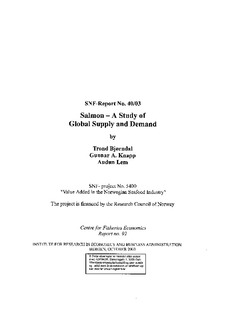Salmon : a study of global supply and demand
Research report

View/
Date
2003-10Metadata
Show full item recordCollections
- Reports (SNF) [542]
Abstract
The international markets for salmon have developed enormously over the last decades. Total global supply of farmed and wild salmon has increased almost fourfold from 550,000 tonnes in 1980 to more than 2 million tonnes in 2002. The main cause of the supply increase is a rise in aquaculture production from less than 15,000 tonnes in 1980 to an estimated 1.3 million tonnes in 2002. Since 1997 supply from aquaculture has been higher than from wild salmon fisheries. The major producers of farmed salmon are Norway and Chile. Of wild salmon, the largest suppliers are the USA, Japan and the Russian Federation. The most important markets for salmon are the European Union, Japan and the USA. New salmon markets are developing in Central and Eastern Europe, South East Asia and China, and in South America. With growing output, prices on salmon have shown a long-term decline, although price vacillations from year to year may be significant, due to short-term swings in supply. Production costs in aquaculture have also decreased thanks to economies of scale, improved technology and better feed. Salmon consumption is increasing in most markets and new product variations and value-added products are being introduced. Industry observers expect consumption of salmon to grow further, although at lower growth rates than experienced so far.
Publisher
SNF/Centre for Fishery EconomicsSeries
Report2003:40
Report
92